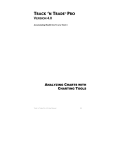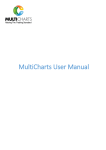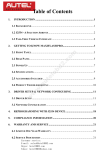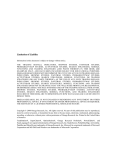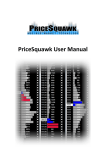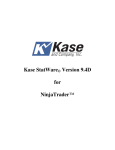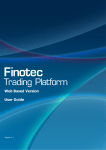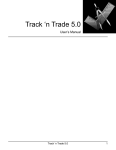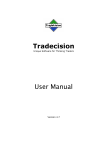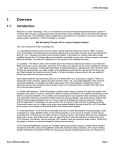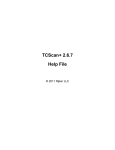Download Kelly`s Cycle Identifier™
Transcript
Software user manual for all our indicators including Floor Traders Tools & TrendPro All the software was designed and developed by Roy Kelly Pro Trend Inc. 2533 N. Carson St. Suite P361 Carson City, NV 89706 (775) 443-7677, Fax: (775) 627-9999 Email: [email protected] Web site: www.trendpro.com All Rights Reserved Reproduction in whole or in part forbidden PRINTED IN THE UNITED STATES OF AMERICA Copyright 1987 - 2009, Roy Kelly 1 All the indicators and packages in this manual make up the Total Traders package. Total Traders Package …….... 3-38 Floor Traders Tools ……….…… 3-20 TrendPro ………………………...… 21-26 Other customer indicators …. 27-40 Copyright 1987 - 2009, Roy Kelly 2 Kelly's Cycle Identifier™ You may have heard that the plots of this indicator disappear, this is not entirely true. That’s a user preference feather that turns this on/off. The indicator will plot the chevrons (peaks and valley) but they are all clearly marked with a dot of where they were, and the dots never change, they are fixed. It is true the chevrons can move, but if you want to see where they were, there will be a dot marking the place where they were. Once you learn my trading method, you will clearly understand why you do not want to see some of the chevrons on the screen. If you want to mark them and keep tract of where they were, the indicator can do this for you. How to set this up is all covered in the user manual and on-line videos. You may have seen what looks like this indicator on other web sites, or that make such a claim; however, you can be assured that it is not authentic. I am the designer, and developer of this indicator, and the way it plots the Chevrons (peaks and valleys). Others have made poor attempts of copying it. The way this indicator plots, and the name of it "Cycle Identifier" are Trademarks of Roy Kelly and this indicator is copyrighted by Roy Kelly. The "Cycle Identifier" Indicator is a very powerful trading tool for identifying cycle tops and bottoms as they occur. The combination of the "Cycle Copyright 1987 - 2009, Roy Kelly 3 Identifier", "Cycle Turn Points", and "Cycle Forecaster" indicators are used to trade the market's cycle bottoms and tops, and to confirm trend reversals. The Cycle Identifier identifies a cycle top with a spike up "peak"; a cycle bottom with a spike down "valley". This indicator is not oscillator based; rather, a mathematically based cycle pattern recognition identifier that when combined with other indicators in The Floor Traders Tools, becomes a very powerful method of trading. The Cycle Identifier has proven to be one of the best indicators available for day traders, and position traders. Depending upon the market and time frame, 78 - 84% of the cycle tops and bottoms are identified by this indicator. This is a leading indicator, and often indicates a cycle top or bottom before any other indicator available. Accuracy with any indicator is greatly increased when trading in the direction of the trend and when combined with other indicators in the Floor Traders Tools. As with any indicator, the accuracy is increased by trading it in the direction of the trend. It is not wise to fade the market in an uptrend or buy the market in a downtrend. One of the techniques for identifying the most significant tops and bottoms used with the Cycle Identifier is to plot a longer term and a shorter term Cycle Identifier. The new Cycle Identifier plots both automatically. The shorter term plot is plotted in the lower sub-graph as dark cyan; the longer term is the red line in the middle of the spike. These points are the most significant highs and lows. It is this combination of these two cycles, a major and intermediate, that identifies a possible major reversal in the market. The most tradable tops and bottoms are in the direction of the trend. Copyright 1987 - 2009, Roy Kelly 4 Trident This indicator establishes price balance points, profit targets, stops, and entry price. If B2 was above B6 for the last swing, and B6 is above B2 for the current swing, then P3 for the current swing will be below B6 and the next valley after the current swing will terminate a downtrend. If B6 was above B2 for the last swing, and B2 is above B6 for the current swing, then P3 for the current swing will be above B6 and the next peak after the current swing will terminate an uptrend. The Expert Commentary is only a feature of TradeStation, neither eSignal, MultiCharts, MCFX Pro, or NinjaTrader offer this. However, in all three platforms the information is plotted on the chart. The indicator will forecast the next cycle price at P4 before it happens and will determine if the next cycle point is a B2 or B6. This a very powerful indicator once you become familiar with how it works and what it shows in the Expert Commentary. Copyright 1987 - 2009, Roy Kelly 5 In the Expert Commentary it shows the price of the last few cycle points, where to enter the trade, and automatically calculates the profit target and stop. It will give an average price range between cycle highs and cycle lows. This helps in determining whether cycles are tradable or not. If there is very little price movement, it would be prudent to stay out of the market. If the range becomes greater, it will allow the trader to maximize profits and stay in the trade longer. Copyright 1987 - 2009, Roy Kelly 6 Fibonacci Retracements In both rising and declining markets, prices often trade around Fibonacci Retracement levels. When combined with the timing of cycles or swings, these retracements become significant price levels of support or resistance that are frequently followed by a cycle high or cycle low. The colored lines show the Fibonacci Retracement levels on the chart. Floor Traders Tools™ automatically calculates four Fibonacci Retracement levels for cycles and high amplitude swings. The Fibonacci levels are indicated by four colored lines on the chart. The price at the Fibonacci level, and the Fibonacci number is also plotted on the chart, for easy viewing. Copyright 1987 - 2009, Roy Kelly 7 Auto Forecaster™ The Auto Forecaster bands forecast like timing bands. Unlike most timing bands, these work from price recognition rather than averaging a number of bars from an oscillator. In real-time it determines where tradable cycle tops or bottoms are most likely to occur during a band. They do not show up for every cycle top or bottom, as not all cycle tops or bottoms are tradable. If it does not plot a band during a cycle high or low, this does not mean that those cycles have no value, only that the indicator does not recognize them. Price highs and lows occurring in the Bands are often accompanied by the Cycle Identifier™ high/low. In real-time these bands appear on the chart when a top and/or bottom is about to occur. This chart shows the use of the Auto Forecaster™ and the Cycle Identifier™ to help identify cycle tops and bottoms. The lower panel shows Real Time Automatic Bands that occur as Auto Forecaster™ determines when a cycle top and/or bottom is due. In this example, the program suddenly plotted a green Band to indicate a top was about to occur within it. Following the top, Auto Forecaster™ plotted the red Band to indicate a bottom is due to occur within it. Copyright 1987 - 2009, Roy Kelly 8 Fibonacci Extensions The markets make Fibonacci Extensions from cycle swing points. These Fibonacci Extensions are used and capitalized upon by experienced traders. Fibonacci Extensions from cycle bottoms and tops have been a part of cycle analysis for over 90 years. A successful trader will use Fibonacci Extensions combined with trading cycles and major longer-term cycles. This point 'n click Fibonacci Extensions indicator calculates the exact prices from cycle bottoms and tops. Using the relationship between cycles and Fibonacci Extensions most traders are looking for a minimum of a 38% Extensions before considering a buy or sell setup based on the formation of a new cycle bottom or a new cycle top. This is the only Point 'n Click indicator in the Floor Traders Tools™. All the other indicators in the Floor Traders Tools™ are fully automated. Copyright 1987 - 2009, Roy Kelly 9 Dynamic Stops™ These stops are dynamically adaptive and fully automated; designed to keep you in the market longer with limited risk, allowing for bigger and more profitable moves. They will forecast the stop for the next bar before it forms. These trailing stops give a fixed stop about half a point below the last cycle low or above the last cycle high, allowing the market room to breath before it moves. This shows where the maximum stop should be placed, and should be the greatest risk one would take. If the market should whipsaw a little the trader won't get stopped out, as happens with most trailing stop indicators. This indicator does all the work for you. It calculates out the best place to start the trailing stop. After entering a trade you would place a fixed stop, then after the market moves the trailing stop starts to plot and you would raise your stop and continue to do so until you take profits or get stopped out. It has the capability of being used manually; however, it is fully automated and there is no need to point 'n click or move text around the screen. There are two ways of viewing the stop, by using the Expert Commentary and clicking on the last bar, or by using the Cross Hairs and clicking on the bars you want the stop for and viewing it in the Data Window. Copyright 1987 - 2009, Roy Kelly 10 Kelly's Expert This indicator is good for showing long-term trend and helps to identify trend reversals. Different than most overbought/oversold oscillators, this one does not get stuck in the overbought/oversold position very often. When the price moves into the overbought/oversold areas and a major Cycle ID occurs, the market usually reverses. Divergence is much easier to see with this study than other overbought/oversold indicators. If the Alert option is "on" the Alert will sound when the oscillator price crosses over, or under, the overbought/oversold lines. This indicator is a favorite among stock traders. This study uses the Expert Commentary as shown below. Aggressive traders would buy or sell a major cycle top or bottom when the oscillator is in the overbought/oversold position. Copyright 1987 - 2009, Roy Kelly 11 Copyright 1987 - 2009, Roy Kelly 12 Cycle Turn Points This indicator is part of the Trident indicator for Ninja Trader and eSignal. The Turn Points identifies cycle highs and cycle lows, which represent a change in price or percent greater than a minimum predetermined move. It was designed to clearly show cycle tops and bottoms. It will also show major cycle highs and lows. The indicator can be superimposed on the price chart or plotted in a separate sub-graph. It can also find all cycles, past and present. In both rising and declining markets, prices often trade around Fibonacci Retracement levels. When combined with the timing of cycles or swings, these retracements become significant price levels of support or resistance that are frequently followed by a Cycle Turn Point and entry signal. Cycle Turn Points will show cycle tops and bottoms and/or swing highs and lows depending upon how it is set up. It can identify historical cycles, and current cycle swings. Cycle Points show the cycle tops and bottoms with colored dots that display at the tops and bottoms. This identification of a bottom is used to begin the Timing Bands for the approximate cycle bottoms. The chart above shows the Filtered Waves channel, and Cycle Turn Points. Any one of the three cycle bottoms could have been bought and would have been a profitable trade. As the market moves up, the Filtered Waves show the direction of the trend. When the price retraces down to the bottom line, and a cycle bottom forms, this is usually the best place to enter a trade. Copyright 1987 - 2009, Roy Kelly 13 Auto Trend Lines These Trend Lines are fully automated and can be programmed for user preference. Auto Trend Line Up is showing resistance. The Auto Trend Line Down is indicating a breakout to the up-side and shows the Profit Target. This breakout often has the potential for being a good trade. The automatic trend line indicators, "Trend Line Up" and "Trend Line Down" automatically plot a trend line from right to left through recent swing high or swing low points of a selected strength. They keep track of the price relative to the trend line, and when the price breaks through the trend line, a determination is then automatically calculated to see if the breakout is qualified. If the trend line breakout is confirmed, a Green cross is plotted above the down trend line breakout bar and vice versa. If there is a breakout that does not qualify, the program will plot a Yellow cross. Most traders wait for a close above or below the trend line to make the trade. The trend line continues until a new pivot is determined. Once a breakout occurs the indicator will automatically plot a predetermined target for you. You simply put the target price in the input ahead of time, and it will automatically show you the target. If the Alert option is set to "on", the program will also signal the breakout in an Alert window. Copyright 1987 - 2009, Roy Kelly 14 Cycle Timing This one shows where a tradable cycle may occur by painting the price bars before the cycle happens. This study does not show every cycle, only the ones that it recognizes as tradable. Copyright 1987 - 2009, Roy Kelly 15 Filtered Waves The Dynamics of this indicator is quite complex. It analyzes past data to determine the Elliott wave patterns, degree of retracements and then calculates the Standard Deviation for the overall direction of the current trend. The Filtered Waves trend channel shows the trend is up, indicating only mechanical buy signals should be taken. This chart illustrates the use of the Filtered Waves trend channel with the Cycle Identifier and Cycle Turn Points. Cycle bottom #1 shows a major cycle bottom. It is identified by the major Cycle Identifier (the red spike in the middle of the cyan valley) and Cycle Turn Points. This low could have been bought by an aggressive trader. Cycle bottom #2 has a Retracement of .382% and a Cycle Turn Point showing a bottom. The Cycle ID did not plot because there was not enough price movement from the last cycle high to the close of the price bar at Cycle bottom #2. As the price starts to rise, the Filtered Waves trend channel began to plot. Cycle bottom #2 was indicated by the red Cycle Turn Points, retracement of .382% and the price tested the bottom of the trend channels. This low could have been bought by any trader. This low saw a relatively small retracement of the move from Cycle bottom #1 indicating the potential for a sizeable move up. Cycle bottom #3 is also buyable, in that the Trend Channel was up and the dark cyan Cycle ID showed a potential cycle bottom that was confirmed by a Copyright 1987 - 2009, Roy Kelly 16 red dot from the Cycle Turn Points. Prices moved up from Cycle bottom #3 to make a longer-term trade. Trading with cycles will lower one's dollar risk. In general, a protective sell stop would be placed below the last cycle bottom from where the trade was entered. Each trade was followed by a substantial move up to the next cycle top indicated by the Cycle ID and/or Cycle Turn points. It was the Trend Channel that provided the trend overview to buy Cycle bottoms #2 and #3. In rare occasions the Cycle Identifier and the Cycle Turn Points do not line up. The reason is that the Cycle Turn Points are working from the lowest low or highest high at a cycle pivot point. The Cycle Identifier is working from pattern recognition. Copyright 1987 - 2009, Roy Kelly 17 Accumulation/Distribution Based on volume, the standard Accumulation/Distribution is a favorite of stock traders. The Floor Traders Tools™ Accumulation/Distribution is based on price, and yet, it is evaluated the same as a normal Accumulation/Distribution line. Oscillators provide timing levels with the Accumulation/Distribution line crossing over or under the zero line. As with the standard Accumulation/ Distribution indicator, when it is above the zero line, cycle bottoms can be bought; when it is below the zero line, cycle tops can be sold. You can see that it does not matter whether the Accumulation/Distribution is moving up or down. As long as it is below the zero line, the cycle tops can be sold. If the Accumulation/Distribution is above the zero line, then the cycle bottoms can be bought. Copyright 1987 - 2009, Roy Kelly 18 Dynamic Cycles The indicator in the top sub-graph is the Kelly’s Cycle Identifier, and the indicator in the lower sub-graph is the Dynamic Cycles. The Yellow and Red lines on the price are for illustration purposes only, they are not part of the indicator. This indicator works great at pin-point cycles that are ready to make a move. If a cycle high or low occurs in the area of the Two Red bars, or the Two Yellow bars, the market will usually make a powerful move (as you can see in the chart above). The Dynamic Cycles indicator works very well with the Kelly’s Cycle Identifier by filtering out many of the un-tradable tops and bottoms. Copyright 1987 - 2009, Roy Kelly 19 Momentum Forecaster This indicator was developed over twelve years ago. Its design was based on the B2 - B6 analysis from my book. This indicator has the ability to forecast a large move in the market 1-2 cycles before it happens. There is not another indicator anywhere like this one; this is a one of a kind. The interpretation of it is easily understood, and traders can employ it to identify their next trade. The main feature is its ability to forecast a large price movement before it happens. A significant move in price usually occurs after the two lines approach the zero line, or become even with it. This would indicate that the next price move in the direction of the trend should be substantial. When the aptitude (the distance between the lower and higher line) is about the same distance apart (from box to box) this would indicate that the market is consolidated—and most likely should not be traded. If the aptitude (the distance between the lower and higher line) is exceedingly far from the zero line, the market is typically going to make a large move shortly. Copyright 1987 - 2009, Roy Kelly 20 TrendPro Stops These are trailing stops and show you where to exit the trade and provide stops for long positions or short positions. It colors red dots for a up trending market and blue dots for a down trending market. The stops are adaptive and move with the market. They can also be used as profit targets. The stop losses are determined by the markets price momentum. When you enter the market, this indicator will continue optimizing your stops, locking in profits, and at the same time they provide the user complete flexibility. This indicator has Strength and Money Management input settings allowing the user to trade the market at their own level of risk. The default setting works best for most traders. Copyright 1987 - 2009, Roy Kelly 21 TrendPro Trigger Points Trigger Points act as a system, in the respect that it shows the user the best place to enter a trade. This indicator pinpoints Buy & Sell signals based on the latest technology available today. When there is a Buy or Sell condition this indicator colors a big blue dot for a Buy or a big red dot for a Sell. A sound alert can also be given. It works great for Chart Scanning, saving hours of work. Copyright 1987 - 2009, Roy Kelly 22 TrendPro Trend Up Down These two indicators provide market direction and keep you trading in the direction of the trend. When the market changes direction or stays in an upward trend the price bars turn blue and remain blue. When the market changes direction to a downward trend the price bars turn red and remain red. If there is a sideways market or the market has no direction then the bars turn a neutral color. Copyright 1987 - 2009, Roy Kelly 23 Trendicator This indicator is a very powerful trend indicator when used in conjunction with the Kelly's Cycle Identifier. Many of you who have been in my chat room wondered how we were calling major tops and bottoms before other indicators plotted an entry. This is the indicator we use to call those tops and bottoms. Wait for a high or low cycle to plot, and when this indicator turns red with a high cycle you enter on the low of the bar the Kelly's Cycle Identifier plotted on. Reverse this procedure for a long entry by waiting for a low cycle to form and then when this indicator turns green you buy the top of the bar. In either instance you may also use the high or low of the bar after the cycle identifier to enter the trade if you missed the bar the Cycle Identifier formed on. Read what this trader had to say: Hey Roy, I have been using your indicators over a year now and must tell you that all of it is really good. But, this new Trendicator, that is really something!!! -- Z.G. Copyright 1987 - 2009, Roy Kelly 24 Kelly's Cycle Identifier™ & Trendicator™ The Trendicator is the Red and Green dots in the middle of the chart. The above chart is showing one way that some traders use it. The Kelly's Cycle Identifier does not come with the Trendicator. Kelly's Cycle Identifier is part of the Floor Traders Tools. Benefits of Trendicator All cycle plots are left on the screen. Entry Price is determined by the high or low of the bar. Gives confidence of the trend direction at trade entry. Pin-points major reversals with the major plot of the Kelly's Cycle Identifier. Extremely early entry prices. Very small stops. Copyright 1987 - 2009, Roy Kelly 25 Trend Filter Identifying trend is a very important part of being able to trade profitably. This indicator will help identify over-all trend. If the indicator value is positive, the over-all market is bullish. If the indicator value is negative, the over-all market is bearish. Copyright 1987 - 2009, Roy Kelly 26 Fibonacci Confluence Roy Kelly's Fibonacci Confluence Indicator will automatically calculate the most comprehensive Fibonacci Price and Time projections; and show high probability turning points for any market and any time frame. It will also automatically give you all support and resistance levels. This indicator is highly accurate on all freely traded markets including, but not limited to, the Equities, FOREX, E-mini's, and other Commodities. You can day trade, swing trade, or position trade any market with greater accuracy, and with the confidence of knowing where the market will find major support and resistance areas. This is the first fully automated Fibonacci price and time technical analysis indicator that eliminates the speculation, and the mental stress of technical analysis. Copyright 1987 - 2009, Roy Kelly 27 Copyright 1987 - 2009, Roy Kelly 28 Copyright 1987 - 2009, Roy Kelly 29 Two Smooth The Two Smooth is a modified Stochastic. The Two Smooth indicator is used to recognize tops and bottoms of trading cycles in all time frames and all markets. The standard Stochastic often stays in the over-bought or over-sold area for long periods, not showing small retracements that are often tradable in a trending market. However, this indicator will identify most of those tops and bottoms. If the Two Smooth indicator crosses above the lower line (oversold) it indicates a buy signal, and if it crosses below the upper line (overbought) it indicates a sell signal. The Two Smooth indicator lowers the risk of false signals and increases the accuracy of identifying cycle tops and bottoms. The Two Smooth indicator helps show the direction of the market. As with any indicator it is prudent to trade in the direction of the trend. Copyright 1987 - 2009, Roy Kelly 30 Advanced Moving Average The Roy Kelly Advanced Moving Average (Advanced MA) was one of the first (and best) indicators I have designed. Although the Advanced MA works great as a stand-alone indicator, it was originally developed to help filter the trades called by the Kelly’s Cycle ID. I had lost the source code when I lost all my computers to a fire. When searching through a backup disk recently, I found the source code. I started to use it again—and it truly helps. It leads the price action, and when it cups the price at a cycle low or high, these cycles are usually more tradable. The Advance MA in the chart above is in red. The green line is a Linear Regression Curve. The Advanced MA leads the price and moves faster than the Linear Regression Curve. The Advanced MA can reach a greater amplitude than the Linear Regression Curve; thus, making the Advanced MA a more reliable, stronger, and better indicator. Copyright 1987 - 2009, Roy Kelly 31 Andrews Pitchfork Fully Automated Dr. Andrews in the late thirties designed what he called his "median line" theory, which later became known as Andrews Pitchfork, because it looks like a pitchfork. He also went on to say that when prices move toward the middle line of the Pitchfork the price will reverse and return to the outside line, or if the price breaks through the middle line the price will usually continue to move forward to the outside line. The beginning point is A, then B, and the ending point of the following cycle is C. In the case of such a cycle pivot, the Median Line, also known as the handle of the pitchfork, is constructed from point A through the midpoint of swing B & C and is extended right to the end of the chart. Two lines are then plotted parallel to the handle line. One line begins at point B, one line begins at point C, and both extend to the right of the chart. Our Andrews Pitchfork indicator automatically finds the most recent three cycle pivots on a chart and plots a set of lines through these points showing the Andrews Pitchfork. It works on all time charts, including tick charts. Floor Pivots Copyright 1987 - 2009, Roy Kelly 32 This indicator will show the Floor Pivot, Support 1,2,3 and Resistance 1,2,3. Plus is will also show Mid Point, Weekly, Monthly Pivots, Support, and Resistance. This is another indicator I are using to help call tops and bottoms in our chat room. Notice how the price bounces off S1 and then rallies up a little to the pivot area, and then sells off down to S1. Then the price rallied up to R1, sold off R1 back down to the floor pivot area, reversed and rallied up to R2, and then sold off to the R1 level. This is a floor support and resistance indicator that works on tick charts, as well as any other intraday time frame. It also plots the number and the name of the area the line represents. Pvt is the Floor Pivot, R1 is Resistance level one, and S1 is Support level one. This is the only floor and support indicator, that I know of, that will work on tick charts. The floor and support areas are where floor traders in the pits are doing most of their buying and selling; therefore, they are watching these areas very closely. This becomes an even more powerful indicator when combined with the Trendicator and Kelly's Cycle Identifier. When the price is at a floor support or resistance area, and the Kelly's Cycle Identifier spikes followed by the Trendicator reversing direction, there is usually a reversal in price occurring. This is usually a good entry area to catch a major reversal in market direction. Copyright 1987 - 2009, Roy Kelly 33 Benefits of this Indicator Shows where floor traders are looking to buy and sell. Helps determine early Entry Price. Gives confidence of the trend reversals. Names the Support and Resistance lines, and plots the price. Helps Pin-point major reversals. Shows extreme prices. Copyright 1987 - 2009, Roy Kelly 34 Dynamic Trend Filter The above chart shows the Dynamic Trend Filter (the red line) and the Purple Indicator at the bottom is the Kelly’s Cycle Identifier Filtered, and as seen, it picked up the trading cycle in the direction of the trend. This Dynamic Trend Filter indicator is a very useful tool which helps the trader to trade in the direction of the trend. The market does not always trend hard in one direction or the other, which can make trading tricky. When adding the Dynamic Trend Filter as an indicator that can be plotted on the price (or in sub-graph), it acts much like a range finder--how much the price will move from highs to lows. By plotting on the price, what the trader will often see is that the price will bounce off the Dynamic Trend Filter at extremes. The charts below incorporate the Kelly's Cycle Identifier and the Dynamic Trend Filter to demonstrate how this works. Copyright 1987 - 2009, Roy Kelly 35 The Red Line on the price is the Dynamic Trend Filter and the indicator at the bottom is the Kellys Cycle Identifier 2. The Dynamic Trend Filter works very well for finding the trend, and shows the direction of the trend. In addition, the Dynamic Trend Filter indicator can also be plotted in a sub- graph, and/or on the price, to show direction of the trend. If the filter line is up at the top, then the trend is up, if the filter line is down at the bottom, then the trend is down. I prefer to use it on the price as shown above. It works very well at helping to determine where a major reversal will occur as shown at Reference 1. On the above chart, the market was in a down trend. Notice that right when the price reaches the Dynamic Trend Filter's lower line that a major cycle occurs; and hence, the market reverses. It is amazing how accurate The Dynamic Trend Filter is, and how good it performs not only to show trends, but extremes in price as well. Copyright 1987 - 2009, Roy Kelly 36 By observing the above chart, we see the price at Reference 1 reversed and moved up right after the price reached the lower line of the Dynamic Trend Filter. Also notice how the price at reference 2 bounced off the upper line of the Dynamic Trend Filter right at the Peak of the Kellys Cycle Identifier 2. What I like about the Dynamic Trend Filter is that it gets you in a trade at the earliest possible entry--and with a very small stop loss ratio compared to the target. Copyright 1987 - 2009, Roy Kelly 37 Cycle Identifier Filtered The Cycle Identifier is a very powerful trading tool for identifying cycle tops and bottoms as they occur. The Cycle Identifier Filtered indicator is used to find cycle tops & bottoms. I am always trying to improve upon my work and looking for ways to make my indicators perform better. One area of concern for me over the years is the difficulty I have had in trying to teach traders not to sell in an up trending market, and not to buy in a down trending market. It seem to me, that the majority try to counter-trend trade rather than trade in the direction of the trend, and as we all know, this will devour a trading account quickly. I am sure that’s why so many fail trying to trade. So after months of research, I believe I came up with an answer that should help keep traders on the right side of the market by adding a very dynamic filter to the Kelly’s Cycle Identifier. As you can see in the above chart, only the valleys are plotting. This is because the market is in an up trend (working just the opposite for a down trending market). This eliminates the tops that would normally get the trader into an unwanted short position because the direction of the trend is not recognized. The improved version of the Kelly’s Cycle Identifier also greatly reduces phantoms. Phantoms are usually caused by peaks forming in an up trending market, and valleys forming in a down trending market. I once had a trader call me, and say, “The Kelly’s Cycle Identifier has 30% phantoms”. I responded with the question, “Were you counting the peaks in Copyright 1987 - 2009, Roy Kelly 38 an up move, and then counting the valleys in a down move”? He said “yes”. I said, “So then, what you are saying is that when trading it in the direction of the trend it trades at 70% accuracy”? He said, “Oh, I didn’t think of it that way”. So we all have him to thank for this filter, as that’s when I realized the importance of helping traders understand market direction, and trading in the direction of the trend. He later said he was doing great, because he then understood how to use the original Cycle Identifier with the trend of the market. Notice the chart above, how in a bearish move down, the Filtered Cycle Identifier only shows the cycle highs, and eliminates the cycle lows that would most likely become phantom points. Nothing is 100%, as traders we all understand that, but this newly improved limited version should surely help keep us on the right side of the market. Copyright 1987 - 2009, Roy Kelly 39 The filter has been improved Marks the phantom points The idea of marking the phantom points is so that you can back-test it. There are many ways to help with the phantoms, and even though they are filtered a few still happen in the direction of the trend, you can eliminate more by using other indicators in conjunction with the Cycle Identifier Filtered. Copyright 1987 - 2009, Roy Kelly 40









































